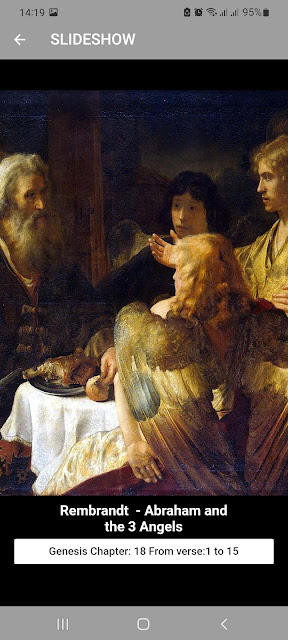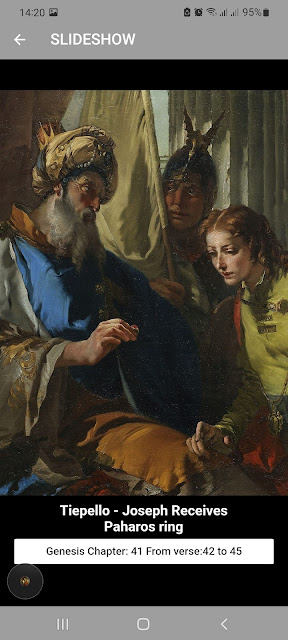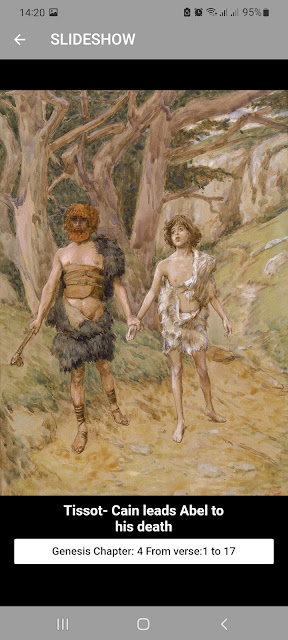Below are various paintings from the Old Testament, found in our Museum of biblical art app, with some history on the same.
1. Arthur Hacker And there was a cry in Egypt Exodus 12:29-30

View more Images here


Arthur Hacker's painting And There Was a Great Cry in Egypt (1897) depicts the final plague that God inflicted on Egypt to force the Pharaoh to allow the Israelites to depart from slavery in Egypt. The plague was the death of the firstborn son in every Egyptian household, from the firstborn of Pharaoh, who sits on the throne, to the firstborn of the slave girl, who is at her hand mill. There was loud wailing throughout Egypt—worse than there has ever been or ever will be again.
The painting is both a historical and religious document. It provides a glimpse into a time when God intervened in human history in a dramatic way. It also reminds us of the power of God and the importance of obedience.
The painting is unfortunately in a private collection.
2. Jacob Jacobsz. de Wet Lot escapes Sodom Gen 19:1-29
View more Images here


The painting shows Lot and his family running away from the city, which is engulfed in flames. Lot's wife is looking back at the city, which is a violation of God's command not to look back. As a result, she is turned into a pillar of salt.
The painting is a dramatic depiction of the story of Lot's escape from Sodom. It captures the sense of urgency and danger as Lot and his family try to flee the city before it is too late. The painting also highlights the importance of obedience to God's commands.
Jacob Jacobsz. de Wet d. J. was a Dutch painter who was known for his religious paintings. He was inspired to paint the scene of Lot's escape from Sodom after reading the Bible passage Genesis 19:1-29. The painting was exhibited at the Amsterdam Guild of Saint Luke in 1660 and was praised by critics for its realism and its depiction of the emotional impact of the story.
3. Phillipe de Champaigne The sacrifice of Isaac Gen 22:1-19
View more Images here


Philippe de Champaigne was a French painter who was known for his religious paintings. The painting shows Abraham kneeling before an altar, with Isaac lying on the altar. Abraham is about to plunge a knife into Isaac's chest, but an angel of God intervenes at the last moment. The angel is shown pointing to a ram, which has been caught in a thicket. Abraham then sacrifices the ram instead of Isaac.
The painting is a dramatic depiction of the story of the sacrifice of Isaac. It captures the sense of tension and emotion as Abraham prepares to sacrifice his son. The painting also highlights the importance of obedience to God's commands.
4. Rembrandt Abraham and the three angels Gen 18:1-15
View more Images here


Rembrandt Harmenszoon van Rijn, commonly known as Rembrandt, was a renowned Dutch painter and etcher who lived from 1606 to 1669. He was a master of capturing light, shadow, and human emotion in his artworks. One of his famous biblical paintings is "Abraham and the three angels," which depicts the events described in Genesis 18:1-15.
In this biblical account, Abraham, known for his hospitality, receives three visitors who are actually angels sent by God. The scene typically shows Abraham outside his tent, respectfully welcoming the three angels. Rembrandt's interpretation of this story is known for its dramatic lighting and emotional depth.
5. Ricci Bathsheba bathing
View more images here


A painting by by Sebastiano Ricci 1720. It depicts the Biblical story (as narrated in 2 Samuel 11) of the seduction of Bathsheba, the wife of Uriah the Hittite, by the Israelite king, David. The painting shows Bathsheba, attended by four maidservants, is taking a ritual bath in the open air whilst being observed by King David from his nearby palace roof.
The painting is oil on canvas and measures 124.5 × 103 cm. It is currently in the collection of the Museum of Fine Arts, Budapest.
6. Rubens Defeat of Sennacherib
View more images here


"The Defeat of Sennacherib" depicts a biblical event described in the Old Testament, specifically in the Book of Kings. According to the narrative, Sennacherib, the king of Assyria, laid siege to the city of Jerusalem. However, during the night, an angel of the Lord descended and struck down the Assyrian army, leading to their defeat.
Rubens' version of this painting is known for its dramatic composition and powerful portrayal of the biblical scene. The artist captures the chaos and terror of the battlefield, with vibrant colors and dynamic figures. The divine intervention of the angel is a central element in the painting, symbolizing the deliverance of Jerusalem from its enemy.
7. Francesco Hayez Joseph and the loose wife of Potiphar
View more Images here


"Joseph and the loose wife of Potiphar," is a painting by Francesco Hayez. Francesco Hayez was an Italian painter who lived from 1791 to 1882 and was known for his historical and biblical compositions.
In Hayez's painting, he depicts the moment from the biblical story of Joseph and Potiphar's wife. According to the biblical account in the book of Genesis, Potiphar's wife attempted to seduce Joseph, who was a slave in their household. However, Joseph resisted her advances, leading to false accusations against him.
Hayez's painting captures the tension and drama of the scene. The painting showcases Hayez's skill in capturing emotions and storytelling through visual composition.
8. Jan Steen The wrath of Ahaserus Esther 7:1-10
View more Images here


Jan Steen, a Dutch Golden Age painter, painted a scene based on the biblical story of Esther titled "The Wrath of Ahasuerus" or sometimes referred to as "Esther Denouncing Haman." In the Book of Esther, the story recounts how Queen Esther, at a banquet hosted by King Ahasuerus (also known as Xerxes I), reveals the evil intentions of Haman, one of the king's advisors who sought to destroy the Jewish people. As Esther denounces Haman, the king becomes filled with anger, leading to his decision to punish Haman for his treachery.
Jan Steen's painting portrays this climactic moment of Esther's revelation and the king's furious reaction. The composition typically features Esther at the center, pointing towards Haman, who is shown in a state of shock and fear. King Ahasuerus, often depicted with an expressive and wrathful countenance, reacts to Esther's words.
9. Giovani Batista Tiepelo Joseph receives Pharaohs ring Gen 42:41-45
View more Images here


Giovanni Battista Tiepolo was an Italian painter of the 18th century. Tiepolo was known for his religious and mythological paintings including "Joseph receives Pharaoh's ring" based on Genesis 42:41-45. Tiepolo did create several paintings based on the life of Joseph.
10. Tissot Cain leads Abel to his death Gen 4:1-17
View more Images here


James Tissot, also known as Jacques Joseph Tissot, was a French painter and illustrator of the 19th century widely known for his biblical paintings. Tissot's biblical illustrations often featured detailed and realistic portrayals of characters and settings.
Enjoy!









